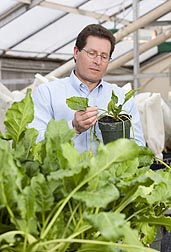Washington, DC, USA
January 10, 2012
 U.S. Department of Agriculture (USDA) scientists are helping sugar beet producers increase yields, protect their produce from disease, and boost profits. The research conducted by Agricultural Research Service (ARS) scientists in Kimberly, Idaho, supports the USDA priority of promoting international food security. ARS is USDA's chief intramural scientific research agency.
U.S. Department of Agriculture (USDA) scientists are helping sugar beet producers increase yields, protect their produce from disease, and boost profits. The research conducted by Agricultural Research Service (ARS) scientists in Kimberly, Idaho, supports the USDA priority of promoting international food security. ARS is USDA's chief intramural scientific research agency.
ARS plant pathologist Carl Strausbaugh (photo) and ARS molecular biologist Imad Eujayl have studied sugarbeets from the field—where a strong wind can twist tiny seedlings right out of the ground—to the processing factory. Some of their work has focused on the root disease called rhizomania, which is caused by beet necrotic yellow vein virus (BNYVV) and reduces sugar levels in harvested beets. A single dominant gene in sugarbeet helps protect the plant from rhizomania, but some strains of the virus have evolved to overcome this genetic resistance.
For two years, the team grew approximately 30 commercial sugarbeet varieties in fields that were naturally infested with BNYVV. Then they collected samples from each variety—all of which showed some evidence of typical rhizomania infection—and calculated the average sugar content of each variety.
After harvest, other beets grown in the experimental fields were stored either indoors or outdoors for more than four months. In a post-storage survey, the scientists found that the beets stored indoors had lost as much as 100 percent of their sugar content, and that the sugar content in beets stored outdoors had dropped as much as 60 percent. The scientists also observed that the beet varieties exhibiting the greatest resistance to rhizomania and good storability—indicated by the lowest levels of fungal growth and lowest levels of weight loss from root damage—also had the highest sugar levels.
The team also developed a set of genetic markers for beet curly top virus that plant breeders could use in developing curly top-resistant sugarbeet varieties. They identified 11 genetic markers that were significantly associated with resistance to curly top and found that five of the 11 markers were linked to phenotypic resistance traits.
Results from this work have been published in Plant Disease, Journal of Sugar Beet Research, Phytopathology, and elsewhere.
Read more about this work in the January 2012 issue of Agricultural Research magazine.
Photo by Peggy Greb.
Las remolachas azucareras se benefician de las investigaciones científicas
Científicos del Servicio de Investigación Agrícola (ARS) están ayudando a los productores de las remolachas azucareras a aumentar rendimientos, proteger sus cultivos contra enfermedades, y aumentar sus ganancias.
Los estudios realizados por los científicos del ARS en Kimberly, Idaho, apoyan la prioridad del Departamento de Agricultura de EE.UU. (USDA por sus siglas en inglés) de promover la seguridad alimentaria internacional. ARS es la agencia principal de investigaciones científicas del USDA.
Patólogo de plantas Carl Strausbaugh y biólogo molecular Imad Eujayl han estudiado las remolachas azucareras desde el campo, donde los vientos fuertes pueden rasgar la planta del suelo, hasta la planta de procesamiento. Algunos de sus estudios se concentraron en la enfermedad llamada la rizomanía, la cual ataca las raíces de la planta y es causada por el virus de la vena amarilla necrótica (BNYVV por sus siglas en inglés). Esta enfermedad reduce los niveles de azúcar en las remolachas cosechadas. Un solo gen dominante en la remolacha azucarera ayuda a proteger la planta contra rizomanía, pero algunas cepas del virus han evolucionado para vencer esta resistencia genética.
Por dos años, el grupo cultivó aproximadamente 30 variedades comerciales de remolacha azucarera en campos infestados naturalmente con BNYVV. Luego los investigadores colectaron muestras de cada variedad—todas de las cuales mostraron síntomas de infección con rizomanía—y calcularon el contenido medio de azúcar en cada variedad.
Después de la cosecha, otras variedades cultivadas en los campos experimentales se almacenaron a cubierto o al aire libre por más de cuatro meses. En una evaluación después de la cosecha, los científicos descubrieron que las remolachas almacenadas a cubierto han perdido hasta el 100 por ciento de su contenido de azúcar, y el contenido de azúcar en las remolachas almacenadas al aire libre ha disminuido por hasta el 60 por ciento.
Los científicos también observaron que las variedades de remolacha que demuestran los niveles más altos de resistencia a la rizomanía y la mejor tolerancia al almacenaje—como indicado por los niveles más bajos del crecimiento de los hongos y la pérdida de peso como resultado de daños a las raíces—también tuvieron los niveles más altos de azúcar.
El grupo también identificó un grupo de marcadores genéticos del virus del ápice rizado de la remolacha que los criadores de nuevas variedades de plantas pueden usar en el desarrollo de nuevas variedades de remolacha azucarera con resistencia a esta enfermedad. Los investigadores identificaron 11 marcadores genéticos relacionados con resistencia al virus del ápice rizado y descubrieron que cinco de los 11 marcadores fueron asociados con rasgos fenotipos de resistencia.
Los resultados de estos estudios han sido publicados en las revistas 'Plant Disease' (Enfermedades de Plantas), 'Journal of Sugar Beet Research' (Revista de Investigaciones sobre la Remolacha Azucarera), y 'Phytopathology' (Fitopatología).
Lea más sobre esta investigación en la revista 'Agricultural Research' de enero del 2012.